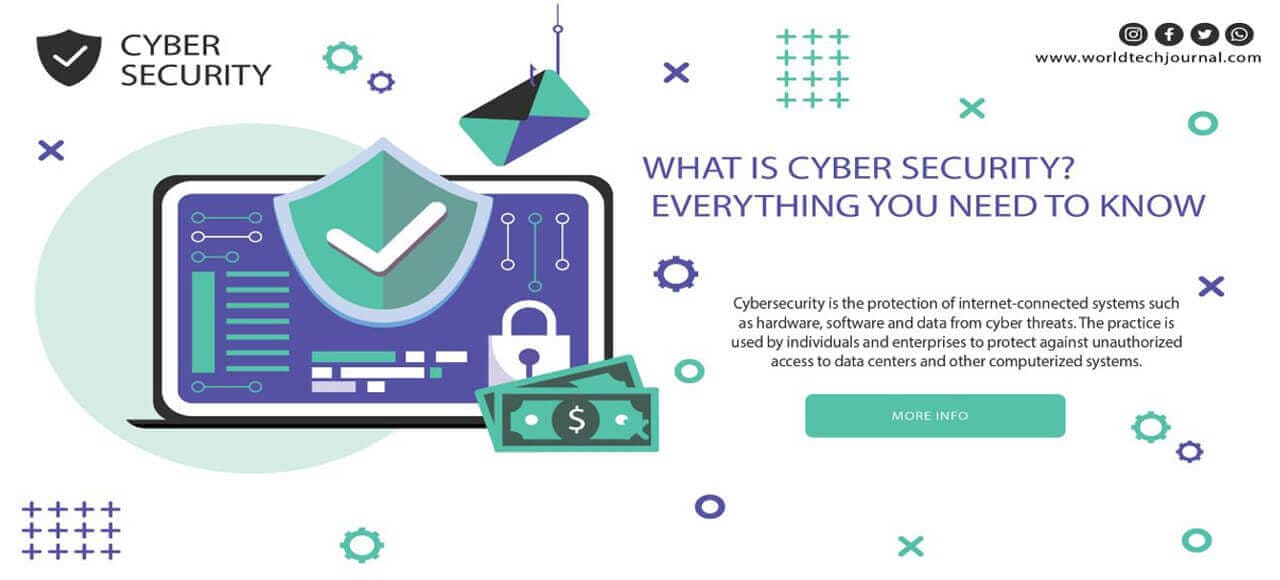Cyber security is the defense against online threats for hardware, software, and data that are linked to the internet. Individuals and businesses both utilize this technique to prevent illegal access to data centers and other digital systems.
A solid cybersecurity plan may provide a decent security posture against hostile assaults intended to gain access to, change, delete, destroy, or extort sensitive data and systems belonging to a business or user.
Security measures are essential in preventing attacks that try to take down or impair a system or device’s functionality.
What makes cyber security crucial?
The significance of cyber security is only going to expand as there are more people, devices, and programs in the contemporary company, along with an influx of more data, most of it sensitive or secret.
The issue is made much worse by the increase in the quantity and level of sophistication of cyber attackers and attack methodologies.
What is cyber security, and how does it operate?
The subject of cybersecurity may be divided into a number of distinct parts, and it is essential for an organization’s cooperation within that field to have a successful cybersecurity program.
The following is a list of these sections:
- Security for applications
- Security of information or data
- Network protection
- Planning for business continuity and disaster recovery
- Operational protection
- Cloud safety
- Security for vital infrastructure
- Physical protection
- Client Education
For many firms, maintaining cyber security in a threat environment that is continuously changing is difficult.
Traditional reactive strategies, which focused resources on defending systems against the most significant known threats while leaving less significant threats undefended, are no longer an effective method.
A strategy that is more proactive and adaptable is required to keep up with shifting security dangers. A number of significant cybersecurity consulting bodies provide direction.
For instance, as part of a framework for risk assessment, the National Institute of Standards and Technology (NIST) advises implementing continuous monitoring and real-time assessments to protect against both known and unidentified risks.
What advantages does cyber security offer?
- The advantages of putting cybersecurity procedures into place and sustaining them include:
- Protection for businesses against cyberattacks and data breaches.
- Network and data protection.
- Preventing access by unauthorized users.
- Quicker recovery after a breach.
- End-user and endpoint device security.
- Regulation observance.
- Company continuity
- Increased trust from stakeholders, consumers, partners, developers, and workers in the company’s reputation.
What sorts of cyber security threats are there?
It may be difficult to stay on top of emerging technology, security trends, and threat information. It is required to safeguard data and other assets from many types of cyber threats. Some examples of cyber threats are:
- A sort of harmful software known as malware allows any file or program to be used against a computer user. Worms, viruses, Trojan horses, and malware are included.
- Malware may also include ransomware. It entails an attacker encrypting and locking the victim’s computer system files, then demanding cash to decode and unlock them.
- An attack known as social engineering uses human contact to persuade users to circumvent security measures in order to get sensitive information that is ordinarily protected.
- Phishing is a kind of social engineering in which phony emails or texts are delivered that seem to be from reliable or well-known sources. These communications, which are often random assaults, aim to steal sensitive information like credit card numbers or login credentials.
- A specific individual, company, or organization is the targeted target of a spear phishing
- Security lapses or losses brought on by people, such as staff members, subcontractors, or clients, are referred to as insider threats. Insider dangers may be malicious or careless.
- Attacks known as distributed denial-of-service (DDoS) involve many computers interfering with the operation of a targeted system, such as a server, website, or other network resource. Attackers may slow down or disrupt a target system by flooding it with messages, connection requests, or packets, blocking legitimate traffic from accessing it.
- Advanced persistent threats (APTs) are targeted assaults that last a long time and include an attacker infiltrating a network and avoiding detection for a long time in order to collect data.
- Attacks called “man-in-the-middle” (MitM) include an assailant intercepting and relaying communications between two parties who they think are in communication with one another.
Botnets, drive-by-download attacks, exploit kits, malicious advertising, vishing, credential stuffing assaults, cross-site scripting (XSS) attacks, SQL injection attacks, business email compromise (BEC), and zero-day vulnerabilities are additional frequent forms of attacks.
What are the main difficulties with cyber security?
Hackers, data loss, privacy concerns, risk management, and evolving cybersecurity tactics all present ongoing threats to cybersecurity.
In the foreseeable future, it is not anticipated that the number of cyberattacks would decline. Additionally, the emergence of the internet of things (IoT) has added attack access points, necessitating a greater requirement for network and device security.
The fact that security dangers are always changing is one of the most challenging aspects of cybersecurity. As new technologies arise, and as technology is employed in new or different ways, new attack avenues are generated.
It might be difficult to keep up with these constant changes and advancements in assaults and to update procedures to defend against them.
Concerns include making sure that all cybersecurity components are regularly updated to guard against any vulnerabilities. For smaller firms without the workforce or internal resources, this may be particularly challenging.
Additionally, businesses have access to a wealth of information on people who use one or more of their services. The risk of a cybercriminal wanting to steal personally identifiable information (PII) increases as more data is gathered.
For instance, a ransomware assault may target a company that saves personally identifiable information in the cloud. Organizations need to take all reasonable precautions to avoid a cloud breach.
End-user education should be a part of cybersecurity measures, since staff members may unintentionally introduce malware into the premises on their computers or mobile devices.
Employees who regularly get security awareness training may help protect their firm from online dangers.
Lack of competent cybersecurity staff is another issue facing cybersecurity. Businesses need cybersecurity employees to assess, monitor, and react to problems as the quantity of data they gather and utilize grows.
The shortage of security experts in the workforce, according to (ISC)2, is projected at 3.1 million.
How does cybersecurity leverage automation?
Automation is becoming a crucial part of keeping businesses safe from the many and sophisticated cyber threats that are on the rise.
Cybersecurity may be enhanced in three key areas by using artificial intelligence (AI) and machine learning in sectors with high-volume data streams:
- Threat recognition Platforms powered by AI are able to evaluate data, identify existing dangers, and forecast new ones.
- Threat reaction Platforms powered by AI can also design and automatically implement security measures.
- Human enhancement Security professionals often have too many warnings and boring duties to do. By automating large data analysis and other repetitive operations, AI may assist reduce alert fatigue by prioritizing low-risk warnings automatically and freeing up human labor for more complex tasks.
Automation in cybersecurity also helps with attack and malware categorization, traffic and compliance analysis, and more.
Cyber security tools and vendors
Cybersecurity vendors often provide a range of security goods and services. Typical security devices and platforms include:
- Identification and access control (IAM)
- Firewalls
- Endpoint security
- Antimalware
- Systems for preventing and detecting intrusions (IPS/IDS)
- Prevention of data loss (DLP)
- Detection and reaction at the endpoint
- Event management and security data (SIEM)
- Tools for encryption
- Scans for vulnerabilities
- Internet-based private networks (VPNs)
- Platform for protecting cloud-based work (CWPP)
- Broker for cloud access security (CASB)
Check Point, Cisco, Code42, CrowdStrike, FireEye, Fortinet, IBM, Imperva, KnowBe4, McAfee, Microsoft, Palo Alto Networks, Rapid7, Splunk, Symantec, Trend Micro, and Trustwave are a few well-known cybersecurity providers.
What job prospects exist in cybersecurity?
People with cyber security knowledge and hardware and software expertise are required as the cyber threat environment expands and new dangers, such as IoT threats, arise.
Security positions need IT specialists and other computer experts, including:
- The chief information security officer (CISO) is responsible for managing the IT security department’s operations and implementing the security program throughout the whole company.
- The person in charge of a company’s physical security and/or cybersecurity is known as the chief security officer (CSO).
- Security engineers concentrate on quality assurance inside the IT infrastructure to safeguard firm assets from attacks.
- The vital infrastructure of an organization must be planned, assessed, designed, tested, maintained, and supported by security architects.
- Planning security procedures and controls, safeguarding digital assets, and performing internal and external security audits are just a few of the duties that security analysts are responsible for.
- Penetration testers are ethical hackers who examine the security of systems, networks, and apps in search of flaws that hostile users can use against them.
- Threat analysts who seek out weaknesses and assaults with the intention of thwarting them before they damage a corporation are known as threat hunters.
Security consultants, data protection officers, cloud security architects, security operations management (SOC) managers and analysts, security investigators, cryptographers, and security administrators are further professions in the field of cyber security.
Finding employment in cyber security
Despite the fact that each organization has its own unique needs for cyber security positions, you could discover some similar themes.
Let’s examine some of the prerequisites in more detail and discuss how to fulfill them in order to get your first cybersecurity position.
Educational requirements
A bachelor’s degree in computer science, information technology, or a similar discipline is often listed as a qualification for security positions. Although degrees are often held by workers in the cyber security sector, they are not necessarily necessary.
More than half of the 1,024 cybersecurity professionals surveyed by (ISC)2 in the US and Canada said that a cyber security education is “good to have” but not “essential.” Only an associate or technical degree was held by almost 20% of individuals polled with less than three years of experience.
A bachelor’s or master’s degree may often expand your employment options, increase your competitiveness as a candidate on the cybersecurity job market, or help you grow in your profession.
You may focus your study on cyber security in certain degree programs, such as the Online Master of Computer Science from Arizona State University (accessible on Coursera).
Certifications in cyber security
Over half of all cyber security job advertisements need at least one qualification, according to a survey on recruiting conducted by Burning Glass Technologies. There are more than 300 different certifications available, and the quality varies.
Consider beginning with a more fundamental certification, such as the CompTIA Security+, if you are new to cybersecurity. From there, you may start accumulating the job experience required to get more specialized certificates.
A highly desired cyber security skill
Because there are so many open cybersecurity roles, possessing the correct skills might help you get a job.
Start developing your technical and professional skills via online classes, boot camps, or independent study to be ready for a cyber security position. A excellent place to start is with these abilities:
- Cloud safety
- Languages for programming, particularly scripting
- Encryption
- Risk evaluation
- Detection of intrusions
- Finding solutions
- Rationality of thought
Locating entry-level positions
More than half of the security experts polled by (ISC)2 began their careers in cybersecurity with an entry-level position in IT.
Before taking on the additional duties of a security job, you may establish yourself inside a company and develop your technical abilities by beginning as an IT support technician or network administrator.
Additionally, the National Security Agency (NSA) provides Development Programs in Cyber security Engineering and Operations. These three-year, full-time, paid positions encourage participants in developing new skills or changing careers.
When you’re prepared to begin searching for cyber security employment, go beyond the typical job sites (LinkedIn, Indeed, ZipRecruiter, etc.). There are a few websites that focus on offering jobs in technology and cybersecurity, such as:
- Dice
- Net
- NinjaJobs
To Conclude
If cybersecurity is new to you, you can begin your career as an entry-level IT professional in a position as a help desk technician, network administrator, or software developer.
Many people who work in cybersecurity do so after obtaining some IT experience as a junior information security analyst.
Spend some time honing your basic IT competencies, such as programming, networks and systems administration, and cloud computing, before applying for your first cybersecurity position.
Although you don’t necessary need a degree to work in cyber security, having some kind of formal training might enhance your job search.
Recommended articles:
10 Best way of how to make money blogging
How to start a podcast and make money podcasting




